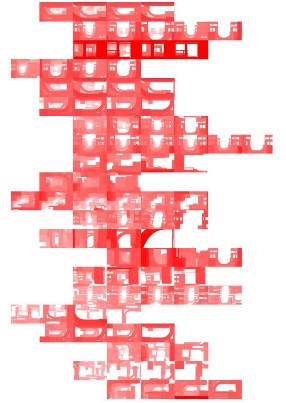伦敦大学学院 (University College London)
Why Enfilade?
Object-Oriented Designing
Architects have always considered most about objective factors such as functions and costs when designing buildings. This design approach is called object-oriented designing in this paper, which is not determined by the architects, but by social reality.
The Second Industrial Revolution simulated the revolution of housing technology and modern architecture. It is also called the Technological Revolution, started in the final third of the 19th century and lasted to the beginning of the 20th century (Muntone, Stephanie, 2013). The economic saw a great growth from 1870 to 1890. Living quality increased dramatically and the price of goods fell a lot because of the increase of productivity. Lots of talented architects appeared, leading the revolution of modern architecture. One of these pioneers is Le Corbusier.
Subject-Oriented Designing
How can one reliably evaluate architecture to distinguish between excellent design or poor design?
The general architectural design is based on an objective principle. Whether at school or at work, architects are accustomed to designing with objective factors such as plane and budget. There are many architectural design methods that provide an objective framework for architects to design buildings. These methods design buildings in a specific way, in which case the building limits the choices and behaviours of people to some extent. But architecture is for human. Apart from objective factors, should architects design buildings from the perspective of people, which means, from the perspective of subjectivity? In this era, architects can try a new way to design. Here is a concept opposite to objectivity, which is subjectivity. Subjective means one can be influenced by personal feelings, tastes, or opinions. Understanding these two definitions helps to distinguish between objectivity and subjectivity.
The relationship between subjective art and objective architectural design is often confused. Although the results may be the same, the design process behind it may be completely different. Some types of architectural design are more objective following strict rules, and some are more subjective and based on human. The design is complex and needs to be adapted to certain conditions. It can be a new exploration for architects to regard the subjective design method as a new design method.
Designers have long started to explore the relationship between architecture and the human body. This kind of discussion refers not only to the scale and position of people in the building, but also to how people will behave in a certain building.
Here enfilade can be referred as a type of space as the exploration of subject-oriented designing. Because enfilade is such a kind of oriented space. It gives people the right to choose which enfilade to enter. If a building is designed according to the composition of enfilades, then the building can be subject-oriented.
Computational Enfilade Architecture
View enfilades can be visualized as lines. How to arrange these view lines is another way to study combinations of enfilade. Lines can be played in all directions and can have perse intersections (Figure x). According to the lines which have been made to a cluster, group combinations can be applied into lines. Therefore, the lines can have various types of group combinations, achieving perse cluster design.
In machine thinking, every arch hole can be simplified as a red point. Draw lines from one point to another point to show the path of enfilade view. At the meanwhile, set the rule that enfilade can only be defined when the number of continuous points must be equal to or more than three. From this way, Unity can generate such points and lines automatically via designed script. The most important thing is that, the amounts of maximum and minimum continuous points as well as the inclines of enfilade lines are assigned by designers. Designers are capable to set specific rules for machine to form spatial space, like courtyards, squares, or corridors. It is more flexible and efficient to design a large architecture with urban meaning.
Background Panorama Research
Based on the setting of the subjective background, the external environment can be acquired by people inside the building through the enfilade, that is, the perception of the outside of the building is obtained from the framing view. It is possible to make a hypothesis that the views of all subjective backgrounds can be made into a panorama. Then this panorama is the overall understanding of the external environment by the people inside the building.
To see the characteristics of the enfilade more directly, here is a definition of the depth of the enfilade. The wall at 1 m from the camera is defined as red of RBG (255, 0, 0), and the wall 100 m away from the camera is defined as white of RBG (255, 255, 255). In this way, the length of the enfilade can be visualized by the degree of the red. As the camera lens moves, a series of enfilade views can be got, which are regarded as the best representation of the enfilade. All views grouped together form the background panorama of the building. One building, one panorama. This can be a new presentative way of architecture.

Cities in the Future
Mixed-use buildings are intended to combine multiple functions into one complex building. Regardless of the combination, it can be used for a variety of purposes in a building or a small building group. Buildings with multiple uses can adapt to the perse needs of modern people and create a resource-rich community. This architectural mode helps architects rethink how modern urban spaces should be designed.
At this time, the designer needs to consider how the different functional buildings should be combined. One of the most efficient and feasible methods is to design the building elements for each function and then combine them in some established system. The three-dimensional prefab designed in previous chapter can be applied to this certain building for later reproduction.